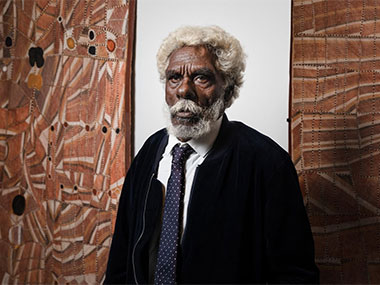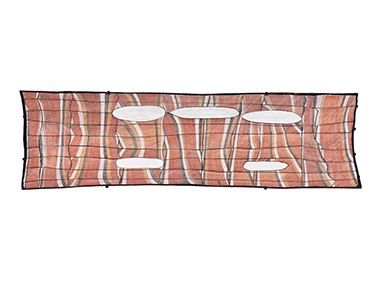Mawurndjul Makes Headlines in DC

Artst Johnny Mawurndjul at the MCA opening of his show
Posted by Jeremy Eccles | 03.09.18
Gallery: Museum of Contemporary Art
Dates:
06.07.18
: 23.09.18
Under the bracing headline: 'Introducing the greatest aboriginal artist unknown in America' expatriate Aussie art critic, Sebastian Smee, a Pulitzer Prize-winner at the Boston Globe, told his now-Washington Post readers what they were missing out on in distant Sydney. Smee has certainly reviewed Australian Indigenous art shows before at US galleries and museums. But I sense that his report from Australia is part of a serious reawakening of interest in Aboriginal art generally across America, vastly helped by the tours of the private collections of Kaplan and Levi and the Scholls to well-regarded art museums across the country, says Jeremy Eccles.
Here is his article, reproduced with Smee's permission:
“In early summer — winter in Australia — an exhibition that the wider world should know about opened in a museum of contemporary art situated between Sydney’s Opera House and Harbor Bridge. The artist, John Mawurndjul, is an aboriginal man with a white beard, a furrowed brow and a springy halo of white hair. Born in 1952, he currently lives in Maningrida, an indigenous community of about 2,000 people in Arnhem Land, on the continent’s north coast, facing Indonesia.
Maningrida is remote — it’s a full day’s drive from Darwin. But, for much of his life, Mawurndjul, who fought off leprosy as a child, has lived on even more remote outstations.
For more than 30 years, he has been making large paintings on massive pieces of bark, which he cuts, using a tomahawk, from stringybark eucalyptuses. He cures the bark over an open fire and flattens the pieces with weights for several days. Then, using thin reed brushes, he patiently applies black charcoal and white, yellow and red ochers (which he finds and grinds himself) in repeating cross-hatched patterns. These patterns nest within a complex overall design that appears figurative or abstract but always expresses ceremonial ritual based in ancient tradition.
Working in this way, Mawurndjul has produced a body of work so sophisticated, so spellbinding and so beautiful that it has earned him accolades not only in Australia (the Sydney Morning Herald’s art critic, John McDonald, recently called him “one of our greatest artists of all time”), but also across Europe.
Mawurndjul has been the subject of retrospectives in Switzerland and Germany. He was featured in the groundbreaking exhibition “Magiciens de la Terre,” at the Centre Georges Pompidou in 1989, and his work is permanently installed in Paris at the Musée du Quai Branly. The 2006 opening of that museum was marked by an issue of Time magazine that placed Mawurndjul’s face on the cover.
People with a glancing sense of aboriginal art tend to bring to mind abstract-looking paintings made up of long strings of dots painted in colored acrylics on canvas. Such work, although it is based in traditions of body painting and sand art, dates only as far back as the early 1970s. That was when Geoffrey Bardon, a white schoolteacher in a central Australian settlement of disparate aborigines displaced by the government’s aggressive assimilationist policies, thought to help remedy a bad situation by encouraging the community’s elders to paint designs relating to traditional ceremonies and myths.
Half a century later, aboriginal art is ubiquitous in Australia. The best of it is showcased in the country’s major art galleries. The tourist market is awash in varieties of cheap, cynically produced and visually cacophonous work.
The movement’s major stars are the late Emily Kngwarreye and Rover Thomas. Among other celebrated figures are Warlimpirrnga Tjapaltjarri, whose 2015 debut in New York drew glowing reviews, and Doreen Reid Nakamarra, who died in 2009 and remains a personal favorite of mine.
Those artists all hailed from the dry regions of central Australia. But about three-quarters of Australia’s aboriginal population live in cities and towns rather than remote outposts. Their creativity, and much about their social plight, is reflected in powerful, politically charged work by the likes of Daniel Boyd, Destiny Deacon, Brook Andrew, Tracey Moffatt and Richard Bell.
American audiences are getting more chances to see art by indigenous Australians. For two years, a changing selection of work from the collection of Miami enthusiasts Dennis and Debra Scholl has been touring the country. It is now at the Phillips Collection in Washington. The Scholls have announced that they are giving around 200 works from their collection to three U.S. museums.
One of them, the Metropolitan Museum of Art in New York, last year mounted a show of six large aboriginal paintings, part of a gift from another prominent private collection. And, in 2016, Harvard Art Museums mounted “Everywhen,” a terrific overview of aboriginal art.
Several commercial galleries in New York, including Salon 94 and Olsen Gruin, regularly show paintings in acrylics on canvas by indigenous Australians. But, so far, American audiences have had almost no exposure to a strain of aboriginal art that many consider just as impressive and at least as inventive: bark painting. This will change in 2020, when a large-scale exhibition of bark paintings from the University of Virginia’s Kluge-Ruhe Aboriginal Art Collection will tour the United States.
Of the artists painting on bark, few would dispute that Mawurndjul is the most accomplished (although he belongs to a dynasty of groundbreaking artists that includes the pioneer Billy Yirawala, Peter Marralwanga, Marralwanga’s son Ivan Namirrkki, and Mick Kubarkku). Mawurndjul began painting for the market in 1979. His work entered the collection of Australia’s National Gallery five years later.
He is an experienced hunter, with deep ceremonial knowledge. When not at Maningrida, he likes to spend time at Milmilngkan, a remote outstation on a creek with nearby waterholes and a spring that bubbles up amid a pandanus grove.
These natural features, along with rainbow serpents, spirit figures, crocodiles and other creatures, all make their way into his paintings. The resulting images, abetted by the subtle undulations in the bark supports, squirm with movement and energy, and vibrate with an almost talismanic potency.
It’s hard to explain in words how the effect is achieved, especially because Mawurndjul’s repertoire of marks is so various. But, in general, an overall format, which might be determined by the edges of the bark itself or by the outline of, say, a rainbow serpent, is subdivided into a loosely shifting grid of dotted lines.
Within each section of this grid, Marwundjul’s distinctive cross-hatching, or “rarrk,” is applied in white, yellow, red, and black stripes. Sometimes the “rarrk” works against the grain of the overall grid, sometimes it is aligned. The colored stripes formed by the “rarrk” may continue in line with those in adjacent sections, but more often they sit at an angle. The eye strains to find a formula behind the jazzy complexity of the whole. But again and again, it is confounded.
Superficially, Marwundjul’s designs can resemble a more complex version of the early paintings of Ellsworth Kelly, who cut his compositions into parallel strips and then randomly rearranged the strips. Or they can be likened to the puzzles of early cubist paintings, with their constant slippages between contour and plane, volume and shadow. But such analogies are necessarily loose. Ultimately, both the visual experience and the worldview underlying Marwundjul’s monumental bark paintings are of an entirely different order.
Mawurndjul, who speaks the Kuninjku language (one of about 120 aboriginal languages still spoken today), judges each painting’s success, he explained, by placing it “in the bush where there are lots of trees. . . . I walk away and I come back and I look at it to see if there’s movement in it. Is it moving? Is there shimmer in it? That’s the power of the rarrk. If it does, I am happy.”
In today’s Australia, aboriginal art is often press-ganged into the cause of the country’s anxious preoccupation with national identity, or promoted as a balm to soothe the open wounds resulting from invasion, murder, mistreatment and a scarcely credible litany of abject failure in government policy.
Outside the country, it might be possible to see the work more clearly. Even so, forms of moral and intellectual vertigo can befuddle the brain of anyone who thinks too long on the origins, development, and reception of contemporary aboriginal art.
If, for instance, you judge the work by criteria that developed in the West around modernist abstraction, you are surely missing the point. But if you treat the best aboriginal work as a mere ethnographic curiosity, you do it — and yourself — an even greater disservice. You overlook not only its extraordinary visual dynamism, but its value as a moving assertion of spiritual vitality, individual brilliance and collective tradition.
This, folks, is what contemporary art looks like. You might not recognize it. The worldview it comes out of might feel deeply, wondrously foreign. But that is part of what draws the eye to it. The awed and baffled mind runs close behind.”
John Mawurndjul, I Am the Old and the New Through Sept. 23, Museum of Contemporary Art, Sydney, then Art Gallery of SA and a two-year national tour.
Sebastian Smee's original review in the Washington Post was published on 31 August 2018.
Share this:
»  del.icio.us
»
del.icio.us
»  Digg it
»
Digg it
»  reddit
»
reddit
»  Google
»
Google
»  StumbleUpon
»
StumbleUpon
»  Technorati
»
Technorati
»  Facebook
Facebook
Contact Details
Gallery: Museum of Contemporary Art
Contact: Curator, Aboriginal and Torres Strait Islander Programs
Telephone: +61 2 9245 2400
Address: Circular Quay West George Street The Rocks Sydney 2000 NSW
Gallery: Museum of Contemporary Art
Contact: Curator, Aboriginal and Torres Strait Islander Programs
Telephone: +61 2 9245 2400
Address: Circular Quay West George Street The Rocks Sydney 2000 NSW

Mawurndjul's 2004 work, 'Mardayin at Dilebang' showing the Old Peoples' bones in stylised form

The MCA's evocatively darkened installation of painted lorrkon, or bone coffins
Where is the exhibition?
Further Research
Gallery: Museum of Contemporary Art
Artists: Brook Andrew | Daniel Boyd | Destiny Deacon | Doreen Reid Nakamarra | Emily Kngwarreye | Ivan Namirrkki | John Mawurndjul | Mick Kubarkku | Peter Marralwanga | Rover Thomas | Tracey Moffatt | Warlimpirrnga Tjapaltjarri | Yirawala
News Tags: Jeremy Eccles | Museum of Contemporary Art Australia | Sebastian Smee | Washington Post
News Categories: Australia | Exhibition | Feature | Industry | Media | News
Exhibition Archive
- 03.09.18 | Mawurndjul Makes Headlines in DC
- 23.08.18 | Indigenous Pots Are Hot
- 19.08.18 | CIAF Sets Records
- 16.08.18 | The Politics of Art in Darwin
- 01.08.18 | A SENSE OF PLACE
- 29.06.18 | INTERNATIONAL ACTIVITY
- 24.06.18 | Blak Markets Back in Sydney
- 22.06.18 | “I am the old and the new”
- 08.06.18 | WARS & MASSACRES
- 03.06.18 | NY “Goes Ballistic” over Aboriginal Art
- 24.05.18 | THE LOCKHART BRAND IS BUOYED UP
- 03.05.18 | THE WYNNE'S A WINNER AGAIN
- 02.05.18 | NATSIAA FINALISTS ANNOUNCED
- 07.04.18 | ENGLAND'S EMILY?
- 04.04.18 | THE SONGKEEPERS
Advertising

